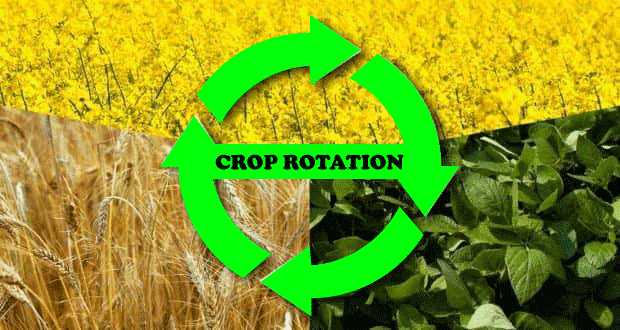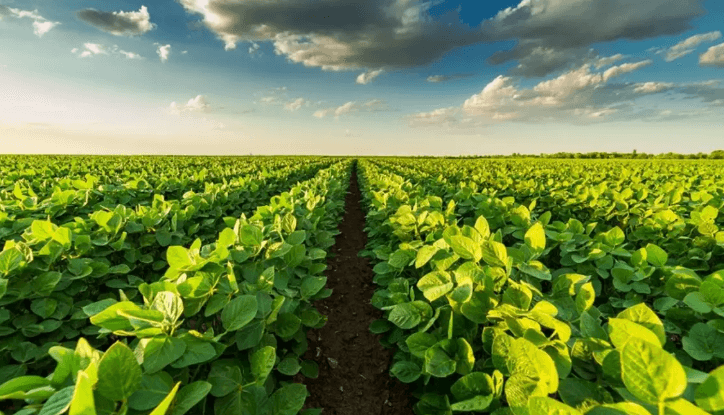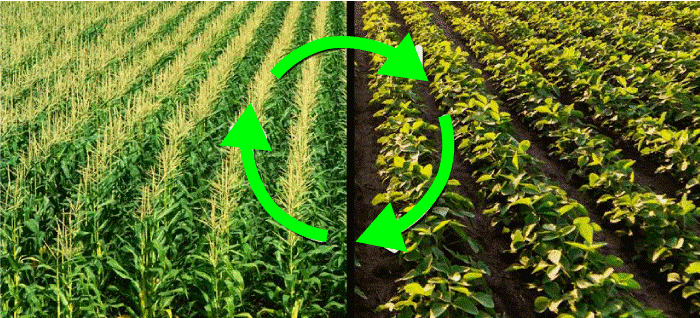Crop Rotation DefinitionCrop rotation is the process of cultivating various crops on the same field across several growing seasons. It lessens dependency on a single source of nutrients, insect & weed pressure, & the likelihood that resistant weeds and pests may emerge. Mono-cropping, or cultivating the same crop in the exact same spot for several years in a row, gradually deprives the soil of some nutrients and favours a highly competitive community of pests and weeds. The production of monocultures relies heavily on outside inputs if nutrient utilization is not balanced and insect and weed communities are not varied. On the other hand, a well-planned crop rotation can lessen the need for artificial fertilizers and herbicides by more effectively utilizing ecosystem services provided by various crops. Crop rotations can also boost soil organic matter and structure, decreasing erosion and strengthening farm systems' resilience. 
HistoryFarmers have known for a long time that fertile soils can be restored or maintained by using the right rotations, such as growing spring crops for cattle instead of cereals for human consumption. Without being aware of chemistry, farmers in the ancient Near East alternately planted wheat and legumes in 6000 BC. Two-field arrangementsA two-field rotation involved planting half of the land in a year while leaving the other half fallow. The fields were then switched around the following year. Both the two- and three-field systems have been utilized in China since the Eastern Zhou era. Farmers in Europe changed from a two-field crop rotation to a three-field crop rotation beginning with the reign of Charlemagne (died 814). Three fields arrangementsFarmers in Europe used a three-field rotation, dividing available land into three portions from the conclusion of the miMiddleges through the 20th century. The first field was divided into three sections: one was planted in the fall with rye or winter wheat, the second with spring oats or barley, and the third was left fallow. By rotating the three fields this way, one would have a break and follow every three years. If one owns 800acres (2.4 km2) in a total of fertile land, they would only be able to plant 300 acres using the two-field approach. One would plant (and subsequently harvest) 500 acres under the new three-field rotation scheme. But, there was more of an impact from the extra crops than just increased output. Most of the spring crops in Northern Europe were legumes, improving the population's general nutrition. Rotations on four fieldsNorfolk's four-course system is an example of rotation on four fields. Early 16th-century farmers in Waasland (in modern-day northern Belgium) invented the four-field rotation, and Charles Townshend (1674-1738), a British agriculturist, popularised it in the 18th century. The four-crop sequence?wheat, turnips, barley, and clover?included a grazing crop and a fodder crop, enabling livestock to breed all year round. The four-field crop rotation was a major development during the British Agricultural Revolution. Ley farming refers to the practice of alternating between ley and arable land. Modern innovationsIn the United States, George Washington Carver (1850s-1943) researched crop rotation techniques and instructed southern farmers to alternate crops that would replenish the soil, such as peanuts and peas, with others that would deplete it, such as cotton. In various world regions, the traditional crop rotation method was replaced during the 'Green Revolution'of the middle of the 20th century by topdressing the soil with fertilizers, such as ammonium nitrate or urea, and adjusting the pH with lime. These techniques attempted to boost yields, prepare the soil for specialized crops by streamlining planting, harvesting, and irrigation, and decreasing waste and inefficiency. Crop SelectionThe following statements about each crop provide a preliminary evaluation of their interrelationships:
The aim of the farmer's rotation, which may include weed control, boosting nitrogen availability in the soil, preventing erosion, and improving soil structure and biomass, to mention a few, is frequently connected to crop choice. Depending on the quality being discussed while discussing crop rotations, crops are categorized in many ways: by family, nutritional needs/benefits, and/or profitability (i.e., cash crop versus cover crop). For instance, appropriately focusing on the plant family is crucial to reducing pests and pathogens. However, the sequencing and placement of cover crops around desired income crops is a strategy many farmers find effective for managing rotations. The classification that follows is condensed and dependent on crop quality and use. Crop RowsRow crops include many essential commodities for the market, such as vegetables. These crops are more demanding on the land, even though they are sometimes the most valuable for farmers. Since row crops often have shallow roots and low biomass, they have little impact on the structure of the soil and add little in the way of waste products. Row crop fields undergo a higher rate of organic matter breakdown by microbes, leaving fewer nutrients for subsequent plants, as a large portion of the soil surrounding the plant is exposed to disruption by rains and traffic. In other words, even though these crops may be valuable for farming, they deplete the soil of nutrients. Crop rotation techniques are used to reconcile immediate profitability with long-term output. LegumesThe interaction between nitrogen-fixing and nitrogen-demanding crops is a key benefit of crop rotation. Alfalfa and clover are legumes that store accessible atmospheric nitrogen in nodules on their root system. Uncollected root biomass decomposes after the plant is plucked, releasing the stored nitrogen for use by subsequent harvests. Legumes have large, deep-dwelling tap roots that elevate the soil to improve water absorption and tilth. Grass and grainsSince to the many benefits they provide to soil structure, and quality, cereal, and grass are frequently used as cover crops. The extensive and extensive root systems give the surrounding soil a lot of structure and a lot of biomass for the soil's organic matter. Grasses and cereals are essential for weed control because they compete with undesirable plants for nutrients and soil space. Green sludgeA crop called green manure is added to the soil. Green manure can be created using legumes that fix nitrogen and nutrient scavengers like grasses. Legumes' green manure is a great supply of nitrogen, particularly for organic systems, but unlike grasses, legume biomass does not build up long-lasting soil organic matter. 
Making a Rotation PlanWhile designing a crop rotation, a lot of things need to be taken into account. The market, farm size, labour supply, weather, soil type, growing procedures, and other constant and variable production factors must be taken into account while planning an effective rotation. A crop rotation should also take into account how one crop might be seeded with some other crop as well as the state of the soil after one crop leaves it for the following crop. For instance, a crop that fixes nitrogen, such as a legume, should always come before a crop that depletes nitrogen. Likewise, a crop with low residue or biomass should be balanced off by a crop with high biomass, such as a mix of grasses and legumes. There is no restriction on the variety of crops that may be utilised in a rotation or the length of time it may take to complete. When a chance to boost earnings or improve soil quality arises, decisions about rotations may be made years in advance, seasons in advance, or even just before the rotation begins. ImplementationCrop rotation techniques, which are widespread in organic cropping systems, may benefit from the effects of additional practices such as the inclusion of animals and manure,intercropping, or multiple cropping. The inclusion of livestockThe most effective way to use important sod and conservation tillage is to add animals since they can spread the nutrients in those crops all throughout the soil through manure rather than taking them away from the farm by selling hay. Managing crops in rotations and cycling nutrients can be accomplished through mixed farming, which is cultivating crops while incorporating livestock. Animals produce manure to replenish crop nutrients and give draught power, and crop residues serve as the animals' food source. These procedures encourage the internal cycle of nutrients and reduce the demand for artificial fertilizers and large-scale equipment. Cattle, sheep, and/or goats have the added benefit of producing milk and serving as a cash crop during bad times. IntercroppingIntercropping and companion planting are two examples of multiple cropping systems that provide more variety and complexity during a single season or rotation. The three sisters' method of interplanting corn with pole beans, pumpkins, and vining squash illustrates companion planting. In this arrangement, the legumes give nitrogen, the corn supports the beans and acts as a "screen" to protect squash vines from pests, and the vining squash acts as a weed suppressant canopy and a deterrent to raccoons that are corn-hungry. Double-cropping is a widespread practice in which two crops, often of different species, are cultivated in succession throughout the same growing season or where one crop (for example, a vegetable) is grown constantly with a cover crop (e.g., wheat).This is helpful for farmlands, which frequently lack the resources to put cover crops in place to restore the soil for as long as big farms can. Small farms that use multiple cropping can optimize the advantages of crop rotation on their existing land resources. BenefitsThe "Rotation Effect" is how agronomists refer to the advantages to yield in crops that are rotated. Rotation systems have a lot to offer. The easing of the detrimental effects of monoculture agricultural techniques is mostly responsible for the aspects connected to the rise. Beneficial rotation effects have been linked, in certain situations, to enhanced nutrition, decreased insect, pathogen, and weed stress, and enhanced soil structure. Production cost improvements are among the other advantages of rotation cropping systems. More diverse agricultural and/or livestock output spreads out overall financial risks more evenly. Input purchases are used less frequently, and eventually, crops can achieve their production targets with fewer inputs. Rotation is a potent technique for enhancing agricultural systems because of this, along with increased short- and long-term yields. Organic matter in the soilIncreased soil organic matter, improved soil structure, and an improved biological and chemically active soil environment are all benefits of using several species in rotation. More SOM results in better water infiltration and retention, which increases drought tolerance and reduces erosion. The organic matter in soil is a mixture of living microbes and decomposing biomass. By its very nature, crop rotation increases exposure to plant detritus such as sod, green manure, and other biomass. Crop rotation requires less intensive tillage because biomass aggregation increases nutrient retention and usage, which reduces the demand for more nutrients. As soil is disturbed and oxidized through tillage, the environment is less favourable for the diversity and growth of soil microorganisms. These bacteria are responsible for supplying plants with nutrients. In contrast, soil with low microbial activity provides plants with considerably fewer nutrients, even though the amount of biomass still in the soil may be the same. This is because "active" soil organic matter is essential to producing soil. Through competition, soil microorganisms also reduce disease and pest activity. Moreover, plants secrete chemicals and root exudates that alter the soil environment and the weed habitat. Hence, rotation reduces allopathy and competitive weed conditions and increases yields from nutrient availability. Sequestration of carbonAccording to studies, crop rotations significantly enhance the amount of soil organic carbon (SOC), the primary component of soil organic matter. Carbon is one of three plant macronutrients, along with oxygen and hydrogen. Long-term rotations with a high degree of diversity have been found to be even more successful at raising SOC, while soil disturbances like tillage are to blame for the exponential drop in SOC levels. In Brazil, SOC sequestration rates of 0.41 metric tons per hectare per year have been observed when no-till technologies are adopted in conjunction with rigorous crop rotations. Sequestration of atmospheric carbon has significant implications for lowering rates of climate change by removing carbon dioxide from the air and improving crop yield. 
Nitrous fixationCrop rotation helps the soil by adding nutrients. Legumes, such as members of the Fabaceae family of plants, have nodules on their root system that are home to rhizobia, a type of bacteria that fixes nitrogen. The rhizobia bacteria take nutrients and water from the plant to transform atmospheric nitrogen into a gas called ammonia. It is subsequently transformed into an organic compound that the crop may use as its nitrogen supply. This process is known as nodulation. Thus, it makes good agricultural sense to alternate them with grains (family Poaceae) and other nitrate-dependent plants. The amount of nitrogen made accessible to the plants relies on a number of variables, including the type of legume, the efficiency of the rhizobia bacteria, the soil's characteristics, and the availability of nutrients essential for plant nutrition. Control of pathogens and pestsPests and illnesses that can slowly infiltrate the soil are also managed by crop rotation. By interfering with the life cycles of pests and their habitats, successive crop changes reduce the population of pests. Pests and diseases are frequently identical among plants in the same taxonomic family. Pest cycles, particularly those that benefit from overwintering in leftovers, can be stopped or controlled by routinely switching crops & keeping the soil occupied with cover crops rather than leaving it fallow. For instance, root-knot nematode, which slowly builds up to high levels in the soil and is a serious issue for some plants in warm climates & sandy soils, can significantly reduce plant output by obstructing circulation from the plant roots. Root-knot nematode levels are drastically reduced in the soil when a crop that is not a host for the nematode is grown for one season, making it possible to plant a sensitive crop the next season without soil fumigation. This technique is especially useful in organic farming when pest management must be accomplished without synthetic pesticides.
Next TopicCustomer Definition
|
 For Videos Join Our Youtube Channel: Join Now
For Videos Join Our Youtube Channel: Join Now
Feedback
- Send your Feedback to [email protected]
Help Others, Please Share










